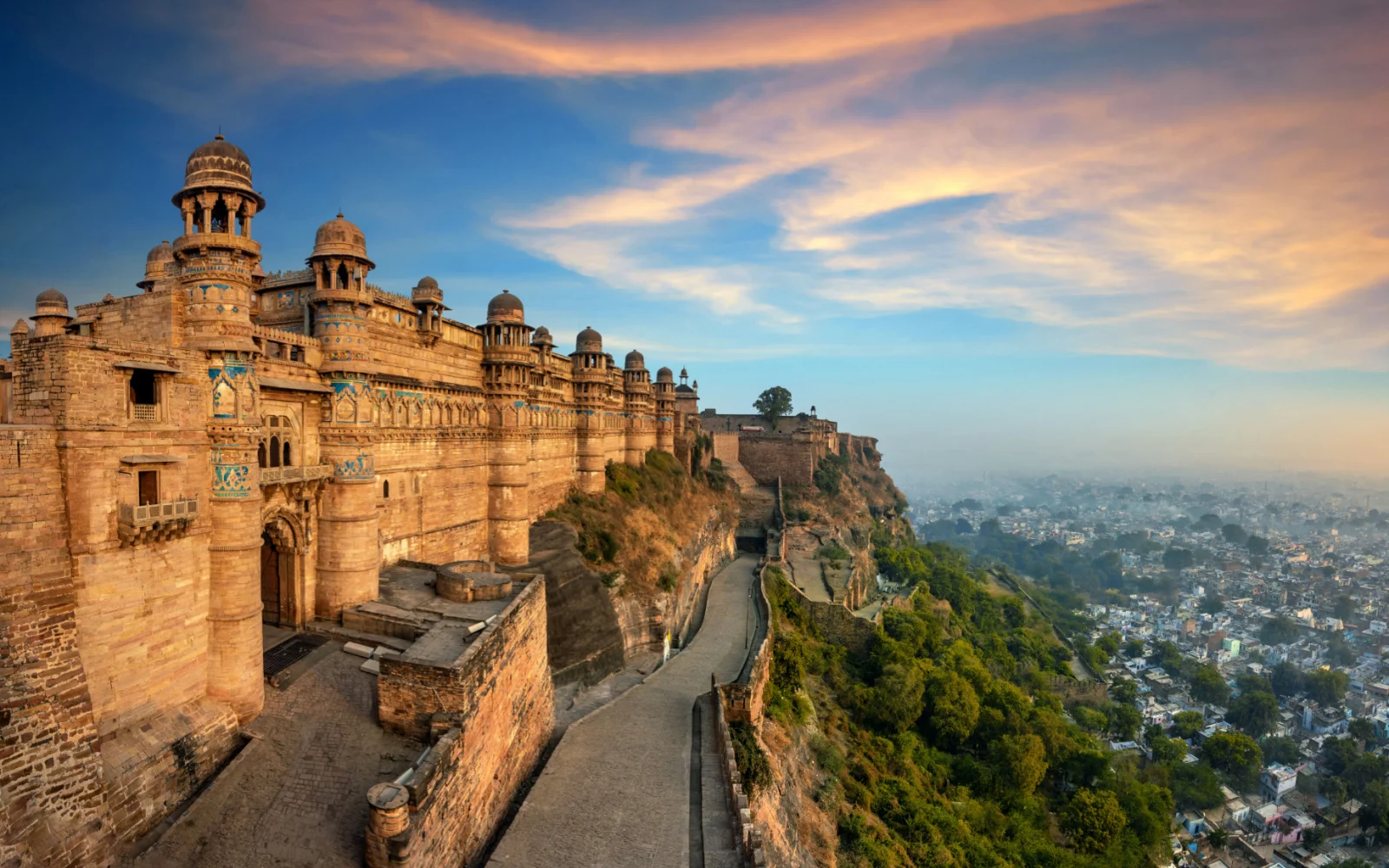The country of India attracts around 18 million visitors annually. Many more people dream of visiting the country but are hesitating to take the plunge.
India has many amazing attractions including UNESCO World Heritage sites such as the Taj Mahal and the Red Fort of Delhi. The vast country contains natural wonders from the Himalayas in the north to the beaches of Goa in the south.
But while it’s beautiful, is India safe to visit? Here’s our take.
Is India Safe to Visit in 2025?
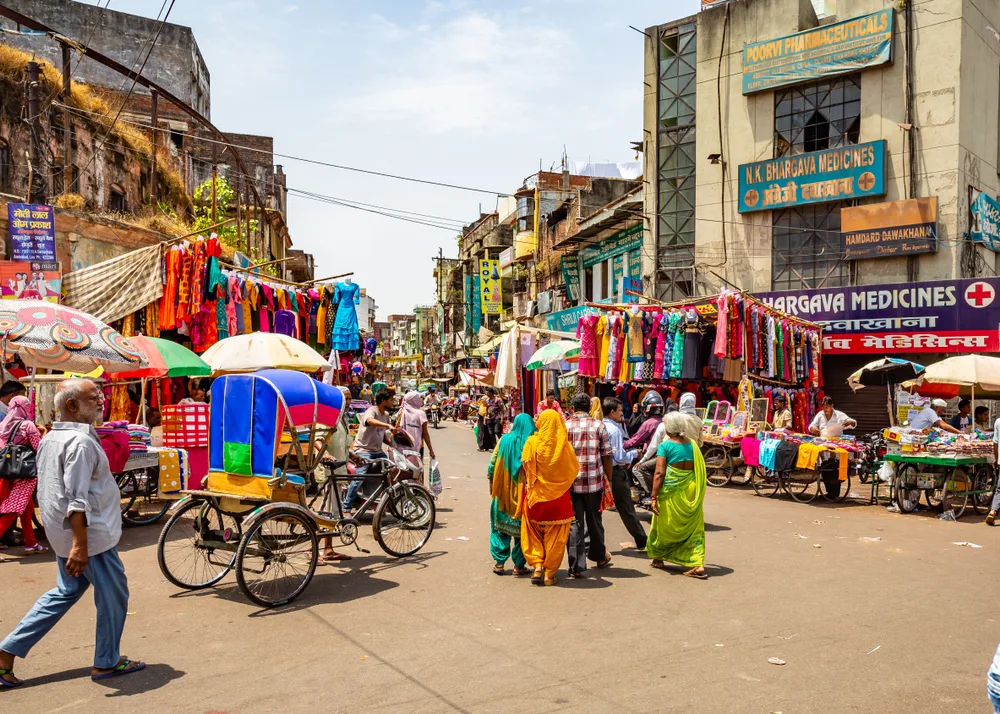
NEW DELHI, INDIA – May 15 2019: Chaotic traffic in old delhi Chandni Chowk market, Street with people and traffic in Delhi , India/Finn Stock/Shutterstock
Yes and no. Ona trip to India, you must be alert at all times. While visiting is possible, you will have to be on your guard against petty theft, scams, and robberies. More violent crimes, such as assault and terrorism, have also affected tourists in the past.
Common problems tourists encounter in India include:
- Pickpocketing
- Bag snatching
- Tourist scams
- Robberies
- Mugging
- Sexual harassment
- Sexual assault
- Murder
- Terrorism
After listing all of these dangers, you might be wondering why people visit India at all. However, remember that India is a very big country, stretching over 1.269 million square miles.
One part of the country might be engulfed in violence, while other regions are perfectly safe. A good place to start researching if a trip to India is safe or not is the travel advisories that foreign governments put out.
Many of them include regional advisories in their breakdowns, so you can get even more insight into planning your itinerary.
The United States State Department has all of India under a Level Two travel advisory, telling its citizens to exercise increased caution due to problems such as terrorism.
The government tells its citizens not to travel to certain regions such as Jammu, Kashmir, the border with Pakistan, the Northeastern States, and Central and Eastern India.
The Australian government has a similar advisory in place. It also tells its citizens to exercise increased caution when visiting India due to threats of civil unrest and crime in addition to terrorism.
The political situation in India is tense, which travelers should be aware of before going. India and Pakistan have tensions going back decades to their respective independence, and there have been border clashes before.
A flashpoint of the conflict is the disputed territory of Jammu and Kashmir, which has been heavily repressed by the Indian government over the past few years.
For those reasons, it is best not to travel to those areas. India also has internal tensions elsewhere. Communal violence, often when militant Hindus attack Muslims during religious festivals, is increasing.
India’s northeastern states, which are home to tribal groups, are often gripped by insurgencies against the government and other forms of violence.
In early May 2023, the state of Manipur experienced ethnic clashes that displaced thousands of people. Besides regular crime and political tensions, India also experiences many terrorist attacks.
There are many terrorist groups operating in the country, including ISIS, al-Qaida, Jamaat al-Mujahideen Bangladesh, and the People’s Liberation Army of Manipur.
Many of these terrorist groups are fueled by the political tensions within India. Millions of people still visit India each year, so clearly it is possible to travel there safely.
Many travelers weigh the risks and the attractions they will see in India and decide that it is worth some danger to see those things. However, it is always good to be aware of potential dangers before you go somewhere.
My Own Experience
My wife and I spent 7 nights in India in 2019 and, while most everyone was quite friendly, there were more than a few times where I felt a bit uncomfortable.
For example, in Jaipur, we walked to the pink city market without a guide. While I never felt particularly unsafe, being rushed by hundreds of shopkeepers can be a little uncomfortable, especially when they are so pushy.
A bit of pushiness in any market is to be expected, but we were clearly tourists, and in this market, there were very few other tourists, so we attracted a lot of attention.
A few days later in New Dehli (a much bigger tourist area), we were walking down the street and were approached a few times by people wanting to “give us directions.” I politely declined, but even these gentlemen were insistent that I let them give us directions.
I had to decline 3 or 4 more times until they finally got the hint. If I were to visit again, however, I’d go with a tour group. In such a group, they know the local customs and politely decline unsolicited offers on your behalf.
That said, even in the bustling markets (pictured below), I never felt unsafe, but rather more alert, as any tourist should be when visiting a busy city.
Crime in India
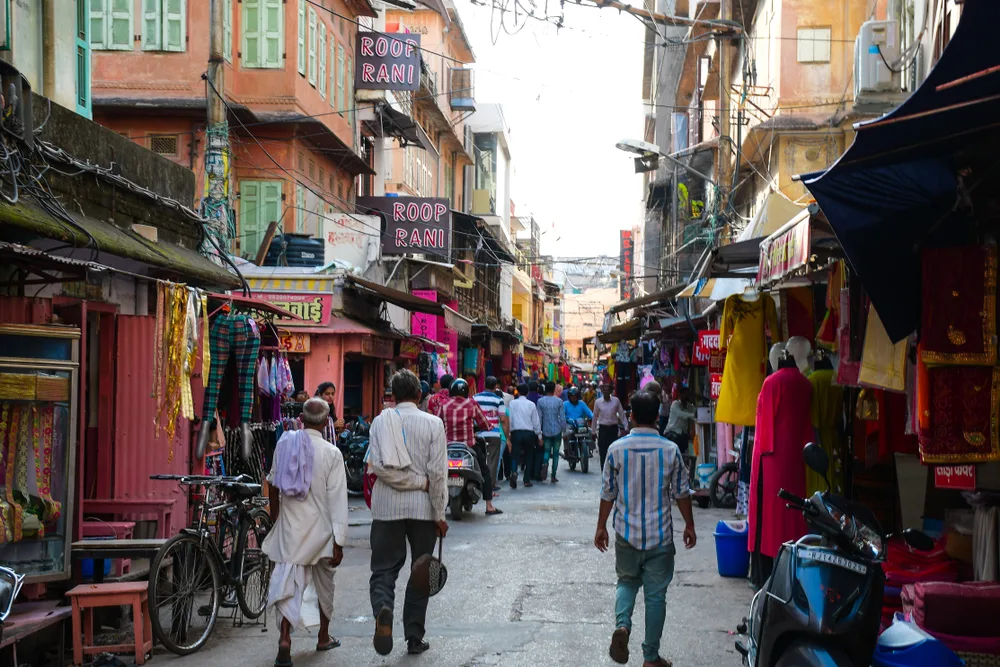
Jaipur, Rajasthan /India – September 11 2018 : Indian people in walking street, Clothe shops market, Street life/LadyRhino/Shutterstock
Crime is one of the primary concerns for visitors when they are planning a trip to India. The crime rate in the country is high, and incidents often affect visitors.
According to the National Crime Records Bureau, the crime rate in 2021 was 268 incidents per 100,000 people, which is a fairly high number.
This crime rate includes just offenses against the Indian Penal Code, while some crime statistics include offenses against state and local laws. 30% of crimes committed in India are violent crimes, or what the government terms “crimes against the body.”
Assault is the most common violent crime, making up 53.2% of all violent crimes. Negligent deaths and kidnapping are also common offenses. Another violent crime that is unfortunately prevalent throughout India is rape.
According to information from the U.S. State Department, rape is the fastest growing crime in India. Violence against women is present in India’s very conservative society.
While this primarily affects local women, foreign women have also been victims of sexual harassment, “Eve teasing” or inappropriate touching, and even assault.
Property crimes are also very common in India. In 2021, there were over 7 million cases of property crimes. The most common type of property crime is theft, making up 77% of total property crimes.
In 2021, there were 23 registered incidents of theft affecting foreigners, but unreported figures are probably much higher.
Petty Theft
The most likely crime affecting foreign visitors to India is petty theft. Theft can take the form of pickpocketing, bag snatching, or tourist scams.
The Canadian government warns in its travel advisory for India that petty theft is common throughout the country. Pickpockets and snatchers operate all over the country, from the busy streets of Mumbai to the beaches of Goa.
They often target trains, stations, markets, crowded streets, and other places where tourists often congregate.
You will need to be on your guard at all times when you are in India to make sure that you leave with all of your possessions in your grasp. Many travelers to India invest in tools that help keep their things more secure, such as money belts.
If you don’t have a money belt, take a few other precautions when going out and about. Only take what you need for the day with you so you have some back-up money just in case.
Keep a copy of your passport and ID at home and one to take with you so you are not carrying around your passport. The Australian government warns citizens that thieves sometimes snatch bags from the backs of motorbikes.
Avoid making yourself a target by wearing expensive jewelry or flashing other valuables (you’ll stick out enough as a foreigner). Wear your bag on the opposite side of the road and opt for a bag that is harder to snatch, such as a cross-body bag.
Scams often target foreigners, so be polite but cautious whenever you meet new acquaintances. Don’t follow touts or someone promising to show you the best hidden attraction in their city.
Scams targeting tourists are now starting to operate over the internet.
Beware of someone contacting you via text or email claiming to be from your embassy and asking to click on a link as that is a common crime people have fallen victim to in the past.
Sexual Violence
Female travelers need to be additionally cautious in India due to the high rate of sexual violence. Most incidents foreign women experience are limited to sexual harassment such as catcalling and unwanted touching.
Although more and more Indians are raising awareness about the negative impacts of “Eve-teasing,” a euphemistic expression for harassment, and it is illegal according to Indian law, it still occurs frequently.
There have also been more violent incidents affecting female travelers. The UK government warns its citizens that foreign female visitors have been assaulted and raped, some even murdered.
Many of these incidents occur in popular tourist destinations and cities such as Goa and Delhi. There is no way to completely avoid the risk of assault, but there are precautions you can take to minimize your likelihood.
Try to travel during the day and limit movements at night to well-lit areas while in a group. Avoid isolated areas such as remote beaches, even during the day. When traveling between cities, there are women-only train cars and bus seats you can choose to use.
If you decide to check out Indian nightlife, make sure you keep a close eye on your drinks. Drink spiking is very common in India and how many criminals incapacitate their victims.
Avoiding Bad Areas
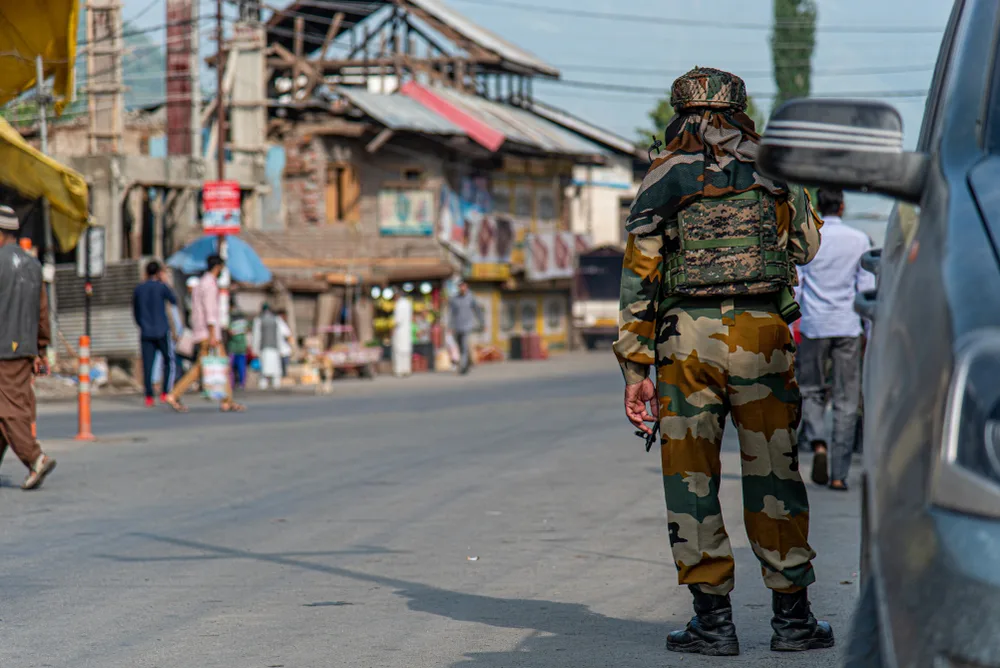
CRPF (Central reserve Police Force) at the market in Srinaka, Kashmir, India. Photo take on 31 July 2019 before govt announced tourist leave Kashmir ASAP/Theeraphong/Shutterstock
Certain regions in India are too dangerous to travel. Do not travel to Jammu and Kashmir due to ongoing government crackdowns, terrorism, and disputes.
This disputed territory between Pakistan and India also has a strong autonomy movement, creating a dangerous situation. Do not travel to the India-Pakistan border (except for the Wagah crossing) due to escalating tensions between the two countries.
Avoid the tribal northeastern states due to conflict and ongoing insurgencies. Manipur recently saw a conflict escalation that displaced thousands of people, and the situation in most of the other states can change at any time.
Avoid traveling to some rural regions of Eastern India as there is an ongoing Maoist insurgency and active terrorism groups.
Things to Consider
Here are some additional safety tips for India:
- Scammers often try to get you to sign up for their guided tours. Never sign up for a tour with a tout, especially if it includes an adventure activity that might be risky. Always sign up for a vetted tour instead.
- India experiences many natural disasters, including heat waves in the summer that are deadly. June to October is monsoon season. Late fall, winter, and early spring are the best times to visit.
- In certain states of India, selling alcohol is illegal. In others, the drinking age may be higher than it is back home. Research rules for drinking before you purchase alcohol to avoid running into legal trouble.
- The culture in India is probably more conservative than you’re used to. Try to adjust to this to fit in by dressing modestly, not overindulging in alcohol, and being respectful when you visit religious sites.
Frequently Asked Questions
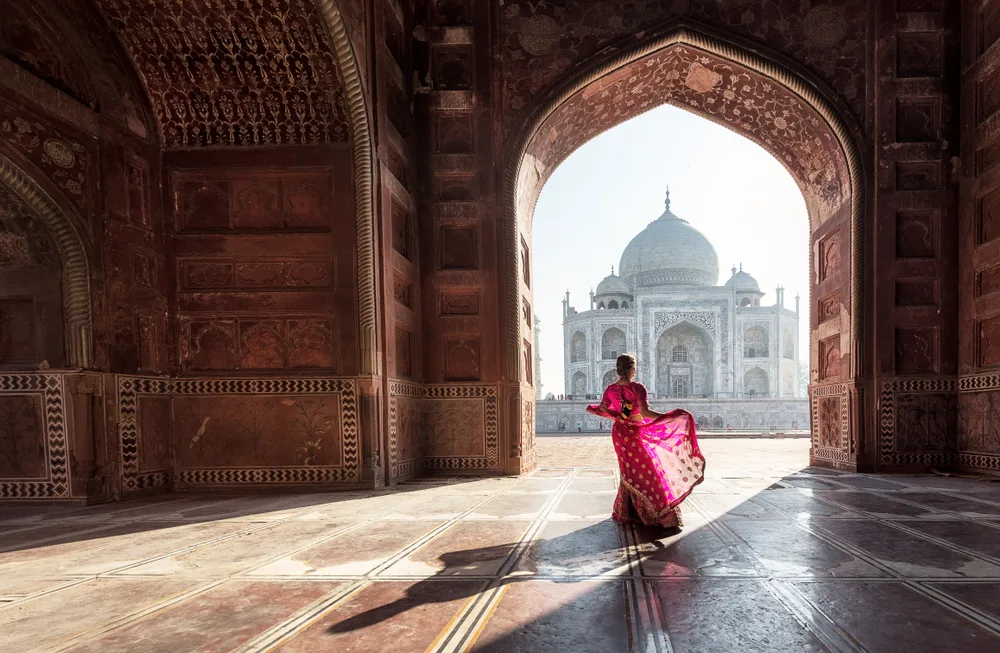
SasinTipchai/Shutterstock
Here are some common questions visitors to India have wanted to ask before:
Are tourists safe in India?
There is no guarantee of safety in India. However, tourists that take the right precautions will probably be safe during their trip.
Is India safe for female tourists?
While many women have a wonderful time traveling through India, you can’t say that India is safe for female tourists due to high rates of sexual harassment and even assault.
Women traveling through India have to take additional precautions to stay safe so it’s probably better for less experienced travelers to go to other places before they visit India.
What should female tourists wear in India?
One way to blend in when going to India as a woman is to try and dress more modestly, like the local women do. Female tourists often wear loose pants or long skirts, T-shirts, and light scarves.
Is India safe to travel alone male?
If you are a man, you will have a much easier time traveling alone in India than a woman. However, you should still stay alert to potential dangers, such as scammers targeting you as a solo traveler.
How safe is Delhi for tourists?
Delhi is moderately safe for tourists. However, the crime rate is elevated, as you should expect from such a big city. Many visitors find the crowds and bustle very overwhelming.
So, Is India Safe to Visit?
India is not the safest place to visit as the crime rate is fairly high. You will have to be on your guard and take precautions for your personal safety as well as avoiding unsafe regions. Still, many people find that a trip to India is rewarding despite the risks. Happy travels!



